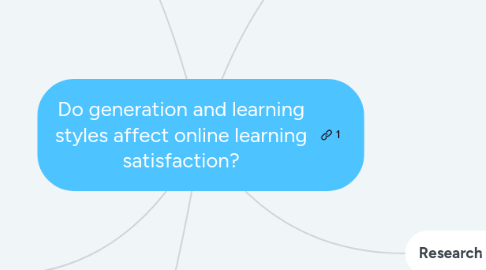
1. Identifying generations
1.1. Generation - cohort with common beliefs due to common social experiences.
1.1.1. useful for interpreting behavior
1.2. GI Generation
1.2.1. 1901-1924
1.3. Silent Generation
1.3.1. 1925-1942
1.4. Baby Boomer Generation
1.4.1. 1943-1960
1.5. Generation X
1.5.1. 1961-1981
1.6. Millennial Generation
1.6.1. 1982-2001
2. Research Method
2.1. correlational study to determine relationships between generation and learning styles and distance education satisfaction
2.1.1. Independent variables
2.1.1.1. Learning styles determined by Felder and Soloman Index of Learning Style instrument
2.1.1.1.1. Active and reflective
2.1.1.1.2. Sensing and intuitive
2.1.1.1.3. Visual and verbal
2.1.1.1.4. Sequential and global
2.1.1.2. Generational demographics identified by Strauss & Howe, 1991
2.1.1.2.1. Baby Boomers
2.1.1.2.2. Gen X
2.1.1.2.3. Millennials
2.1.2. Dependent variables
2.1.2.1. Student satisfaction scores identified using Distance Education Learning Environment Survey (DELES) Instrument
2.1.2.1.1. Examines six DELES predictor variables
3. Participant Demographics
3.1. Total population: 1426
3.1.1. Gender
3.1.1.1. 75.3% female
3.1.1.2. 22.9% male
3.1.2. Ethnicity
3.1.2.1. Native American
3.1.2.1.1. 3.2%
3.1.2.2. Asian
3.1.2.2.1. 1.4%
3.1.2.3. Black
3.1.2.3.1. .9%
3.1.2.4. Hispanic
3.1.2.4.1. 3.2%
3.1.2.5. Caucasian
3.1.2.5.1. 88.3%
3.2. Generational population
3.2.1. Millennials
3.2.1.1. 49.4%
3.2.2. Generation X
3.2.2.1. 35.8%
3.2.3. Baby Boomers
3.2.3.1. 13.1%
3.2.4. Under 18
3.2.4.1. 1.7%
4. Results
4.1. Hypothesis 1
4.1.1. No difference in perceived learning style based on Felder and Soloman ILS among Baby Boomer, Generation X, and Millennial Generation students.
4.1.1.1. Rejected
4.1.1.1.1. Differences found between generational groups regarding Visual – Verbal learning style indicator
4.2. Hypothesis 2
4.2.1. No difference in satisfaction in online courses reported among Baby Boomer, Gen X, and Millennial Generation students.
4.2.1.1. Rejected
4.2.1.1.1. Significant differences found between generations regarding satisfaction with online course
4.3. Implications and recommendations
4.3.1. Need improvements in online education regarding needs of generations
4.3.2. Need improved instructional and learning strategies for the different learning styles
4.3.3. Need more study on learning management systems relationship to satisfaction with online courses respective of learning styles and generation.
4.3.4. Recommends research on providing students information on learning styles to determine if the awareness of preference impacts course satisfaction.
4.3.5. Recommends study on instructor knowledge of learning styles and the relationship to designing effective courses.
4.3.6. Recommends research on impact of instructor training on student satisfaction of online course.
